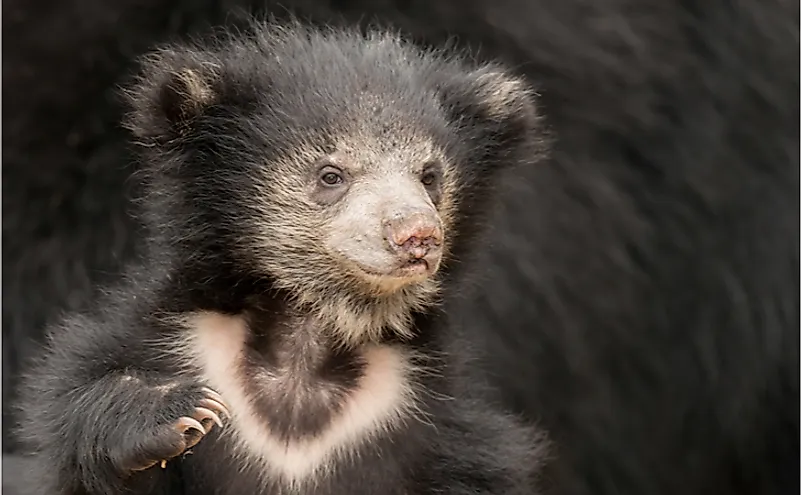Where Does The Sloth Bear Live?

The sloth bear (Melursus ursinus) is a species of bear that is indigenous to the Indian subcontinent.
Where Is The Sloth Bear Found?
Sloth bears inhabit parts of India, Sri Lanka, Bhutan, and Nepal. They were also common throughout Bangladesh, but are now extinct in the region. Their habitat varies significantly and includes dry and wet tropical forests, scrublands, savannahs, and grasslands. The species has also been observed living in tall grasslands that provide dense cover. In most of the Indian subcontinent, the sloth bear is common at altitudes less than 4,900 ft above sea level, while in the dry forests of Sri Lanka they are found in altitudes less than 980 ft above sea level.
Sloth Bear Subspecies
There are two sloth bear subspecies, the Indian sloth bear or Melursus ursinus ursinus and the Sri Lankan sloth bear or Melursus ursinus inornatus.
Indian Sloth Bear
The Indian sloth bear was first described in 1791 by British zoologist George Shaw, who named the bear Ursine bradypus. The name combined the term ursine, which means "bearlike," and bradypus, which means "slow foot." At the time of the species' discovery, Shaw believed the bear was related to the sloth, as bradypusis also the name of the genus for three species of sloth. Later, it was renamed Melursus ursinus ursinus. The Indian sloth bear has a relatively large skull, and its condylobasal length is approximately 12 in for males and 11 in for females. The species is common in India, where it inhabits forested areas and low hills on the outer edges of the Himalayas, ranging from Arunachal Pradesh to Punjab. Sloth bears also exist in conservational areas and sanctuaries such as Balaram, Ambaji, Jessore, Ratanmahal, and Shoolpaneshwar. In Nepal, the species is restricted to the Terai lowland region.
Sri Lankan Sloth Bear
The Sri Lankan sloth bear is smaller than the Indian sloth bear, and therefore its skull is relatively small. The species has a condylobasal length of approximately 9.8 in for females and 10.4 in for males. Its body hair is much shorter and may lack the distinguishing white mark on its chest. Historically, the Sri Lankan sloth bear was common throughout the country, but widespread habitat destruction of their habitats, often linked to the conversion of its habitat to agricultural plantations at the turn of the century, has reduced its population significantly, and the species now only exists in the eastern and northern lowland regions of Sri Lanka.
How Is The Sloth Bear Adapted To Its Habitat?
The sloth bear feeds primarily on termites, ants, and fruits. The species is also referred to as "labiated bear" due to its long palate on the lower lip that is adapted to sucking insects. They lack upper incisors, allowing the tongue to pass-through and suck insects. This unique adaptation also allows the species to use its lower incisors to scrape the bark of trees and reach insects living beneath the bark. They have curved claws that are 4 in length and are suitable for digging and tearing termite mounds.
Sloth bears have a mane surrounding their face, and long and shaggy fur. They share similar features with insectivorous mammals and are believed to have evolved from the brown bear during the Pleistocene era. Sloth bears typically breed in late spring and summer and tend to give birth at the start of winter.
Threats To Sloth Bears
In recent years, the sloth bear population has decreased significantly as a result of hunting, particularly for food, claws, and bacula, as well as habitat loss. Accordingly, the species is now categorized as "Vulnerable" on the International Union for Conservation of Nature's (IUCN) Red List. Occasionally, when its territory is encroached upon, the sloth bear is known to attack humans. Traditionally, the bears have sometimes been tamed and kept as pets by trainers and taught to perform various tricks.











